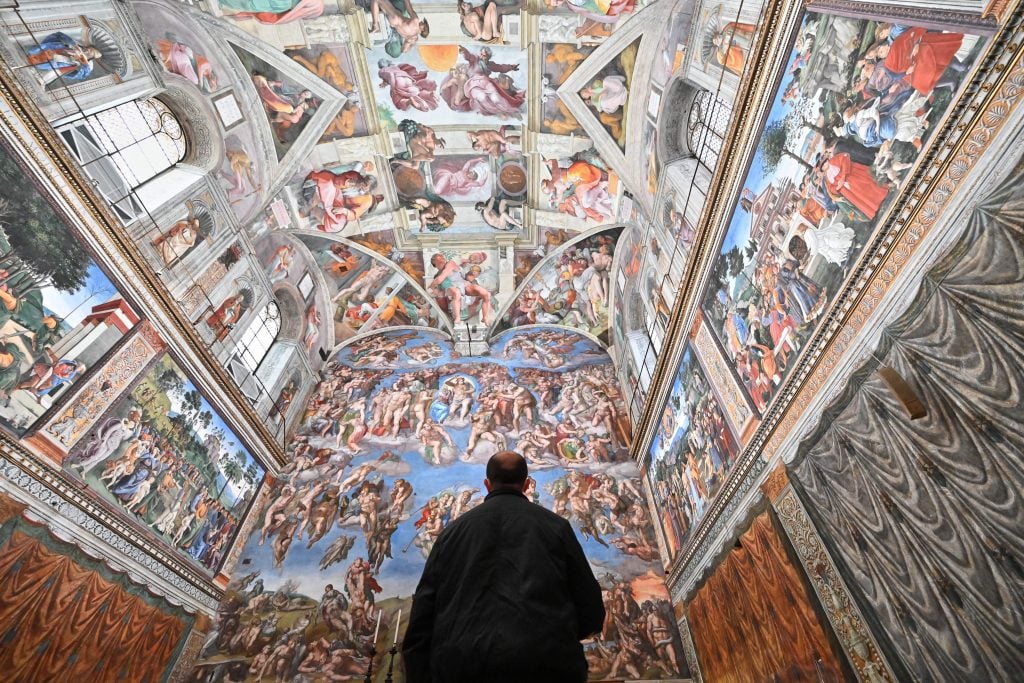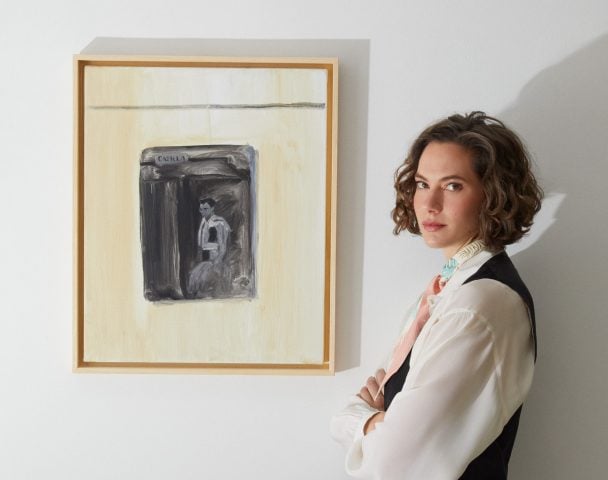In the 2019 Netflix film The Two Popes, which tells the story of Pope Benedict XVI’s abrupt and unprecedented handover of power to Pope Francis, the duo meet early one morning in an empty Sistine Chapel. “You must remember: you are not God, you are human,” Anthony Hopkins’s Pope Benedict tells Jonathan Pryce’s Cardinal Bergoglio, soon to become Pope Francis.
Hopkins points to the magisterial figure of Christ in Michelangelo’s Last Judgment. “There He is,” he says. As Benedict and Bergoglio talk of sin, forgiveness, and absolution, the camera lingers on close ups of the great Renaissance artist’s masterpiece rendered in celestial blues, fiery oranges, and vibrant greens.
Immediately after shooting, that majestic set was destroyed.
The film’s writer, Anthony McCarten, who was nominated for an Academy Award for his screenplay, said the set cost $5 million to make and was a few inches bigger than the real thing. He described its destruction as a “crime.”
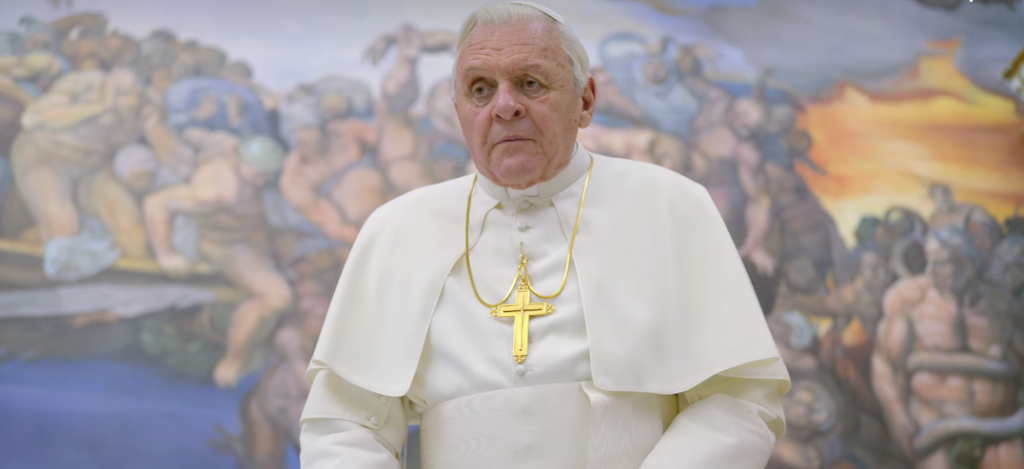
Anthony Hopkins in a film still from Netflix’s The Two Popes (2019). Courtesy of Netflix.
“Disastrously, I watched them wreck it after we finished shooting and I thought, ‘Oh God, I would love to take the end panel’ which was a complete, to-scale replica of the Last Judgment rendered in beautiful, vivid colors,” McCarten, who also penned the Freddie Mercury biopic Bohemian Rhapsody and the Churchill war saga Darkest Hour, told Artnet News. “I thought, ‘What a crime.’”
Netflix declined to comment.
The revelation begs a question: At a time when TV and film productions are churning out increasingly elaborate sets in the streaming era, and audiences remain hungry for IRL immersive experiences, could installations like Netflix’s Sistine Chapel have a second life?
The Vatican rarely gives permission to film inside its borders, which has led filmmakers to come up with ingenious—and often expensive and time-consuming—solutions to reproduce the grandeur of the Sistine Chapel. (See our ranking of the best recreations.)
With the exception of the 1965 film The Agony and The Ecstasy, which shows Michelangelo at work on the Sistine Chapel ceiling (1508–1512), most movies have avoided the difficulties of physically replicating the 66-foot-high frescoes, which would require building a set up to that height or near it. For the most part, the ceiling paintings, including the famous central panel showing God giving life to Adam through his fingertip, have been rendered with special effects, if at all.
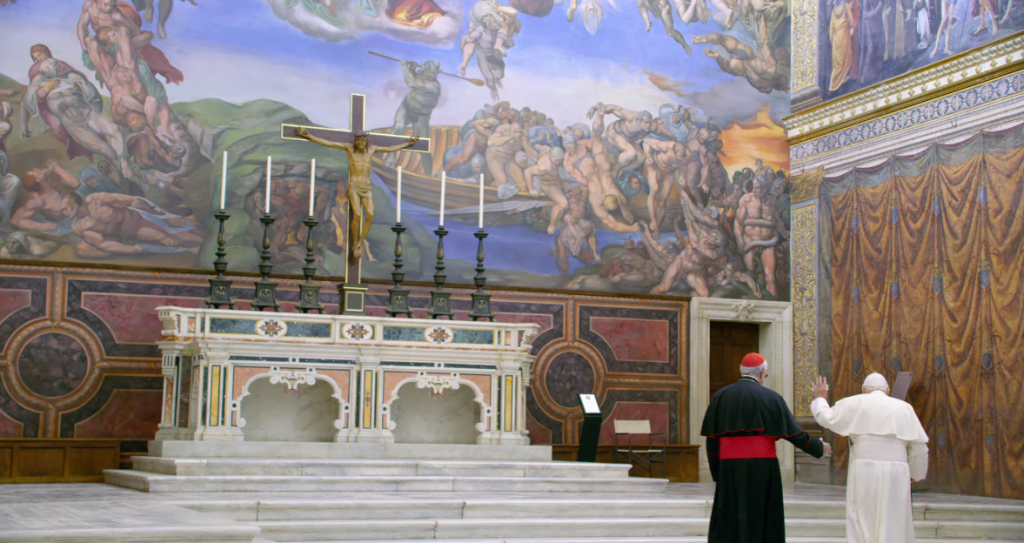
The two popes in front of Netflix’s replica of the Sistine Chapel. Courtesy of Netflix.
In lieu of the ceiling, filmmakers have more often reproduced the artist’s Last Judgment fresco, completed in 1541, which covers the entire back wall of the chapel behind the altar. The dynamic composition of sinners swirling around the central figure of Christ, with the saved being raised up to Heaven on one side while the damned are pulled down into Hell by demons on the other, has been physically replicated multiple times on screen. But it has never been done more effectively than by The Two Popes’ production designer, Mark Tildesley, who reproduced Michelangelo’s masterpiece by hiring a team of artists skilled in recreating classical paintings.
They painted reproductions of the Renaissance artist’s figures, which were then photographed and printed onto sheets of plastic film. The film was placed on the walls of the replica chapel and a chemical substance was applied to it so that the pigment seeped into the wall underneath, just as it does with real frescoes.
This “tattooing” process gave Netflix’s Last Judgment a luminous quality recalling the bright colors and ethereal light of the original after its comprehensive 1980s restoration far more effectively than any previous reproduction. Put simply, with the exception of the real thing, there has never been a better Sistine Chapel on screen.
The replica was constructed at Cinecitta’, Rome’s historic film studios. Its size would have made it almost impossible to store on site and challenging to move elsewhere, but Netflix is not believed to have made any efforts to secure a new home for its spectacular set.
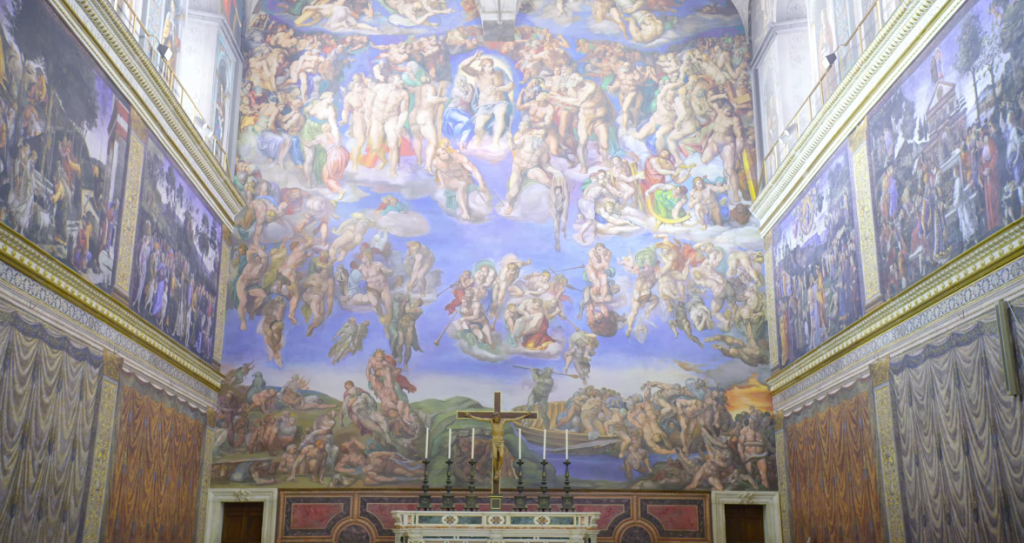
Netflix’s recreation of Michelangelo’s The Last Judgement featured in the 2019 film. Courtesy of Netflix.
“The film industry is horrible like that,” McCarten said. “We build grand, grand pieces of history and, then, we finish shooting and walk off set, get in our cars and, as we’re leaving, we hear the sound of sledgehammers. The work has been so carefully put together and it’s rubble within an hour. You just have to avert your eyes; it’s too distressing.”
McCarten has now turned his focus to a contemporary chapter of art history in the upcoming film The Collaboration, now in pre-production, which will tell the story of Andy Warhol’s friendship with Jean-Michel Basquiat. The play the film is based on, which opened at the Young Vic theater in London in February, transfers to Broadway in November.
So what could Netflix have done with its Sistine Chapel? One option would have been to dismantle the stunning Last Judgment replica and search for a buyer. “When we made Darkest Hour, we recreated Churchill’s War Rooms and ended up selling that to the Queen Mary [a hotel and tourist attraction] in Long Beach, California,” McCarten said. “They bought the whole thing and set it up as a display which is a lovely thing to happen to a very beautifully made set.”
One expert in Sistine Chapel replicas would have jumped at the chance to get his hands on it. “I definitely could have found a use for the Last Judgment,” says Martin Biallas, CEO of SEE Global Entertainment, which organizes touring exhibitions of replica Sistine Chapels, among other shows. “I have wealthy people contact me all the time to ask if they can buy one of my replicas, but I don’t have the license to sell them.”
Biallas currently has 10 Sistine Chapel shows touring the United States, Canada, Europe, Australia, and China. He licenses images of Michelangelo’s frescoes post-restoration from Bridgeman Images—he’s just renewed his licensing agreement for another 10 years—and prints close ups on to a “special fabric which makes it feel like a fresco,” Biallas says. He estimates that over 2 million people have seen one of his Sistine Chapel shows over the last seven years.
“There is an enormous appetite for Michelangelo around the world; there definitely would have been a market for Netflix’s Last Judgment,” he told Artnet News. “People with money like to indulge their passions; I built a whole theme park for one guy in his backyard and for another we recreated the staircase from Titanic.”

Martin Biallas, at home in Los Angeles with a statue of the angel seen at the foot of the staircase in Titanic. Photo: Martin Biallas.
The statue of the angel seen at the foot of the staircase in the blockbuster movie is in Biallas’s own home in Los Angeles. He bought it after producing the official Titanic movie tour in partnership with the film’s director, James Cameron, and its producer, Jon Landau.
“I would absolutely have put that Last Judgment in my house too,” Biallas said, “if I could have.”
